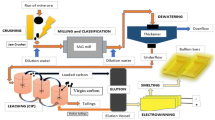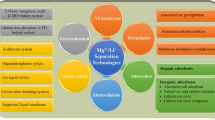Abstract
A study was conducted to control iron in copper electrolyte streams using Eichrom Industries’ new monophosphonic/sulphonic acid resin. The resin strongly and selectively extracts ferric ion over copper and cobalt from highly acidic copper electrolytes. The resin has a loading capacity of 27-g/L iron and can he readily regenerated. In addition, the new resin can easily he synthesized using commercially available starting materials. This paper presents the experimental results for iron control in copper electrolyte streams using the new resin and discusses its potential applications to other hydrometallurgical streams.
Similar content being viewed by others
References
Alexandratos, S.D., Shellwy, C.A., Horwitz, E.P., and Chiarizia, R., 1998, “Mechanism for enhancing ionic accessibility into selective ion exchange resins,” Solvent Extr. Ion Exc., 16, pp. 951–966.
Gula, M.J., and Dreisinger, D.B., 1996, “The ion exchange control of iron in copper electrolyte streams using Eichrom’s DiphonixTM resin,” Preprint 96-039, presented at the SME Annual Meeting, Phoenix, March 11–14.
Author information
Authors and Affiliations
Rights and permissions
About this article
Cite this article
Xue, S.S., Gula, M.J., Harvey, J.T. et al. Control of iron in copper electrolyte streams with a new monophosphonic/sulphonic acid resin. Mining, Metallurgy & Exploration 18, 133–137 (2001). https://doi.org/10.1007/BF03402885
Accepted:
Published:
Issue Date:
DOI: https://doi.org/10.1007/BF03402885




